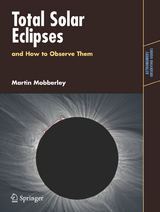Total Solar Eclipses and How to Observe Them
Springer-Verlag New York Inc.
978-0-387-69827-4 (ISBN)
To children the world is full of magical events, and the line between make-believe and reality is (happily) distinctly blurred. However, as we all age and have to be realistic, earn money, become serious and responsible adults (yawn!) and accept that life is short and no one is immortal, those magical events fade and die. We accept that the worlds of make-believe are simply a product of the vivid imagi- tions of great story tellers, and that we are all very similar human beings; just sl- ging away at the tedious day job, and hoping for a win on the lottery. However, there are still a few events which are truly magical and, for me, total solar eclipses (TSEs) are about as magical an event as you can ever experience. Our Earth and Sun are, by a ludicrously lucky coincidence (or, some would argue, by a cosmic architect) almost the same apparent size in the sky. Thus, seventy times a century, the Moon’s shadow passes over a narrow band on the Earth’s surface and, for those on the track, with clear skies, a truly awe-inspiring sight can be seen. But be warned, eclipse chasing is an addictive drug. Once you have seen tot- ity, you will crave more of the same. The sight of an eclipsed Sun is the stuff of science ?ction, but, for the cost of a plane ?ight or an organized holiday, it can be yours, albeit for a few ?eeting minutes.
Martin Mobberley has a BSc Honours degree in Electronic Engineering from Brunel University, and is a former British Astronomical Association President and Goodacre Medallist. He is also the author of Astronomical Equipment for Amateurs (1998) and The New Amateur Astronomer (2004); Lunar & Planetary Webcam User’s Guide (NYP); Supernovae and How to Observe them (NYP),. He has contributed chapters to three other Springer Practical Astronomy Series Books. He wrote the children’s book Space Navigator, and has published many papers in Astronomy Now, The Journal of the British Astronomical Association, The Astronomer, and Sky & Telescope.
Eclipse Mechanisms, Statistics and Tracks.- Why Do Eclipses Occur?.- The Solar Atmosphere.- The Shadow of the Moon.- The Rugged Lunar Limb.- Shadow Bands and Other Phenomena.- Eclipses and Tracks 2008–2028.- Observing and Travelling to Total Solar Eclipses.- Safety First.- Eclipse Trips – The Real Experience.- Checklists and Travel Plans.- Video, Sketch and Savour the View!.- DSLRs and Digital Eclipse Photography.- Some Very Keen Eclipse Chasers.- The H-Alpha Revolution.
| Erscheint lt. Verlag | 19.9.2007 |
|---|---|
| Reihe/Serie | Astronomers' Observing Guides |
| Zusatzinfo | 38 Illustrations, color; 77 Illustrations, black and white; XIV, 202 p. 115 illus., 38 illus. in color. |
| Verlagsort | New York, NY |
| Sprache | englisch |
| Maße | 178 x 235 mm |
| Themenwelt | Sachbuch/Ratgeber ► Natur / Technik ► Weltraum / Astronomie |
| Mathematik / Informatik ► Informatik ► Datenbanken | |
| Naturwissenschaften ► Physik / Astronomie ► Astronomie / Astrophysik | |
| ISBN-10 | 0-387-69827-2 / 0387698272 |
| ISBN-13 | 978-0-387-69827-4 / 9780387698274 |
| Zustand | Neuware |
| Haben Sie eine Frage zum Produkt? |
aus dem Bereich




